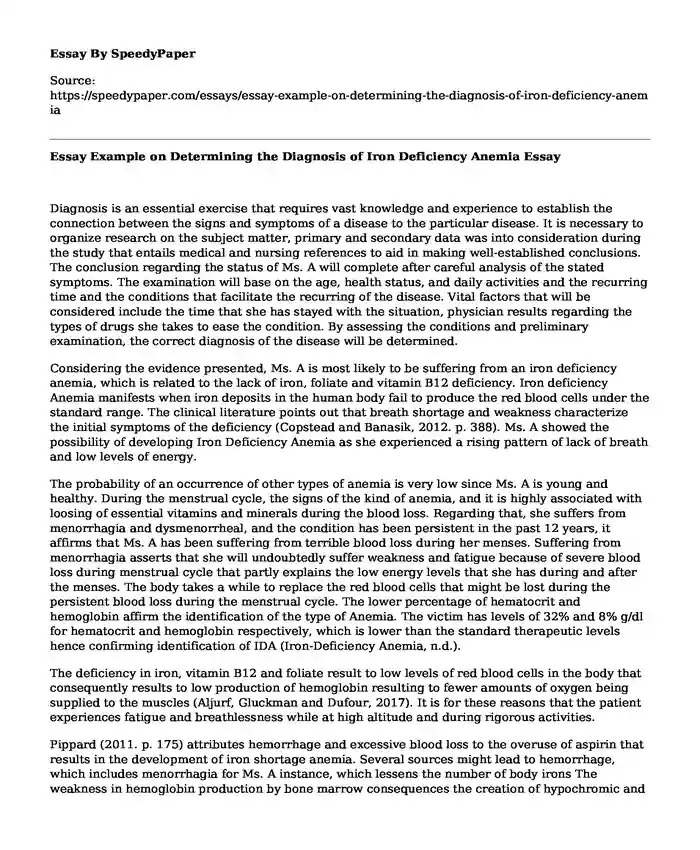Diagnosis is an essential exercise that requires vast knowledge and experience to establish the connection between the signs and symptoms of a disease to the particular disease. It is necessary to organize research on the subject matter, primary and secondary data was into consideration during the study that entails medical and nursing references to aid in making well-established conclusions. The conclusion regarding the status of Ms. A will complete after careful analysis of the stated symptoms. The examination will base on the age, health status, and daily activities and the recurring time and the conditions that facilitate the recurring of the disease. Vital factors that will be considered include the time that she has stayed with the situation, physician results regarding the types of drugs she takes to ease the condition. By assessing the conditions and preliminary examination, the correct diagnosis of the disease will be determined.
Considering the evidence presented, Ms. A is most likely to be suffering from an iron deficiency anemia, which is related to the lack of iron, foliate and vitamin B12 deficiency. Iron deficiency Anemia manifests when iron deposits in the human body fail to produce the red blood cells under the standard range. The clinical literature points out that breath shortage and weakness characterize the initial symptoms of the deficiency (Copstead and Banasik, 2012. p. 388). Ms. A showed the possibility of developing Iron Deficiency Anemia as she experienced a rising pattern of lack of breath and low levels of energy.
The probability of an occurrence of other types of anemia is very low since Ms. A is young and healthy. During the menstrual cycle, the signs of the kind of anemia, and it is highly associated with loosing of essential vitamins and minerals during the blood loss. Regarding that, she suffers from menorrhagia and dysmenorrheal, and the condition has been persistent in the past 12 years, it affirms that Ms. A has been suffering from terrible blood loss during her menses. Suffering from menorrhagia asserts that she will undoubtedly suffer weakness and fatigue because of severe blood loss during menstrual cycle that partly explains the low energy levels that she has during and after the menses. The body takes a while to replace the red blood cells that might be lost during the persistent blood loss during the menstrual cycle. The lower percentage of hematocrit and hemoglobin affirm the identification of the type of Anemia. The victim has levels of 32% and 8% g/dl for hematocrit and hemoglobin respectively, which is lower than the standard therapeutic levels hence confirming identification of IDA (Iron-Deficiency Anemia, n.d.).
The deficiency in iron, vitamin B12 and foliate result to low levels of red blood cells in the body that consequently results to low production of hemoglobin resulting to fewer amounts of oxygen being supplied to the muscles (Aljurf, Gluckman and Dufour, 2017). It is for these reasons that the patient experiences fatigue and breathlessness while at high altitude and during rigorous activities.
Pippard (2011. p. 175) attributes hemorrhage and excessive blood loss to the overuse of aspirin that results in the development of iron shortage anemia. Several sources might lead to hemorrhage, which includes menorrhagia for Ms. A instance, which lessens the number of body irons The weakness in hemoglobin production by bone marrow consequences the creation of hypochromic and microcytic erythrocytes, which are palpable from the results of the findings of the red blood cells smear in the scenario.
As evidenced by the clinical literature, it is patent that the occurrence of iron-deficiency. Anemia resulted from a reduced concentration of serum hemoglobin lower than the optimum level. Indeed, in a clinical context, Ms. A shows a similar pattern of signs that relate to Iron Deficiency Anemia. The clinical literature points out that heavy bleeding during menstrual cycles because of menorrhagia is regarded as a predominant source of IDA in women of reproductive age. Hence, individuals with similar symptoms require an immediate diagnosis for early detection of Iron deficiency Anemia to be able to mitigate it appropriately.
References
Aljurf, M. D., Gluckman, E., & Dufour, C. (2017). Congenital and Acquired Bone Marrow Failure. 312-316. Saint Louis: Elsevier Science.
Copstead, L. C., & Banasik, J. L. (2012) Pathophysiology (5th ed.). St. Louis, MO: Saunders Elsevier. pp.388 ISBN: 9781455726509.
Iron-Deficiency Anemia. (n.d.). Retrieved from https://www.nhlbi.nih.gov/health-topics/iron-deficiency-anemia
Pippard, M. (2011). Iron deficiency anemia, anemia of chronic disorders and iron overload. Blood and Bone Marrow Pathology, 173-195. doi:10.1016/b978-0-7020-3147-2.00011-0
Cite this page
Essay Example on Determining the Diagnosis of Iron Deficiency Anemia. (2022, Jun 15). Retrieved from https://speedypaper.net/essays/essay-example-on-determining-the-diagnosis-of-iron-deficiency-anemia
Request Removal
If you are the original author of this essay and no longer wish to have it published on the SpeedyPaper website, please click below to request its removal:
- 10 Characteristics of a Good Leader in a Free Essay from SpeedyPaper
- Free Essay: Relation of Confidence, Knowledge and Aggression with Leadership
- Essay Example on Organizational Transformation Through Domain Architecture
- Essay Sample on Faith-Based Marketing
- Research Paper on Internal Public Relations
- Health Law - Free Essay Example
- Free Essay Example: The Fight Against Malaria
Popular categories





